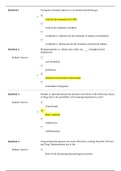Essay
Discuss explanations of a nicotine addiction (16 marks)
- Vak
- Instelling
- Boek
Written by a student who achieved A* in the 2023 Psychology AQA A-level exams. Great template of 16 markers for those needing guidance on the addiction topic. This document consists of 2 questions: 'Discuss the learning theory as an explanation for a nicotine addiction' and 'Discuss the neuroch...
[Meer zien]






